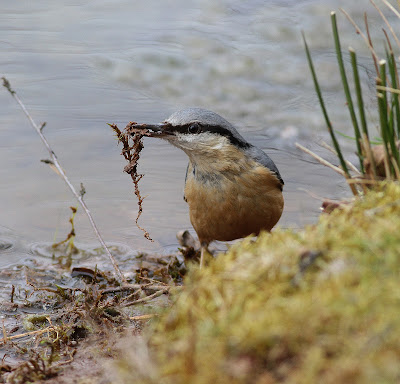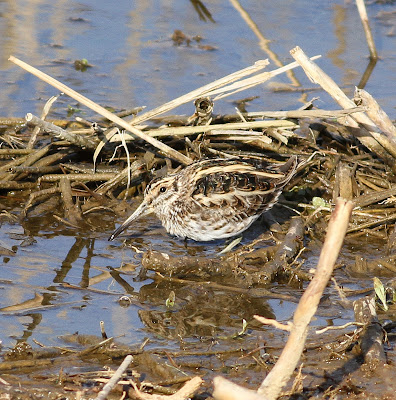I was walking along the saltmarsh at Rainham hoping to photograph a Rock Pipit. There were a few pipits flitting around but as soon as they landed in the tall grass they disappeared. Eventually one came out into the open and I was able to get some shots.
Now the problem with bird photography is that you are more intent on framing the subject and getting the focus right than looking at what you are taking. Therefore, it wasn't until I looked at some of the images on the LCD display that I realised something wasn't quite right. For, rather than photographing a drab dull brown pipit with smudgy streaking on the breast, I was looking at a pipit with grey around the head and an apricot flush to the upper breast, far more reminiscent of a Water Pipit
Anthus spinoletta.
When I got home and loaded the photos onto the computer I was able to study the photos in more detail. The main concern was the short supercilium or eye stripe, which for a Water Pipit should have been long and conspicuous, and the bird had a prominent eye ring. Something wrong here so there was no alternative than to seek a second opinion, which soon confirmed that I was indeed looking at a Scandinavian Rock Pipit.
The nominate race of Rock Pipit Anthus petrosus is found all round the British coast except from Lincolnshire right round to Dorset, and is fairly sedentary. However, Rock Pipits can be seen during the winter months around the eastern coast but these are the migratory Scandinavian Rock Pipits
Anthus petrosus littoralis. During the winter months these birds look identical to the nominate race, but in the Spring the males take on a greyish appearance with an apricot flush on the breast which commonly gets confused with Water Pipits. In Scandinavian Rock Pipits:
a) the supercilium poor and the eye ring is more
prominent.
b) the back is streaked (plainer in Water Pipit).
c) the underparts are heavily (and broadly and
blurry on flanks) streaked, extending too far onto belly, with a complete gorget
necklace more typical of Rock Pipit.
d) the crown and nape do not contrast with the browner back
- a Water pipit has a contrasting grey crown and nape.
So there we have it, my first ever spring littoralis.
For better reproduction of my photos, see my photo gallery at flickr.com/photos/seymourbirdies
.



























































